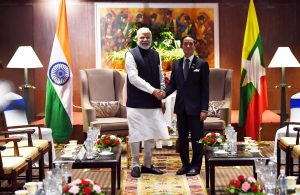A month after Chinese President Xi Jinping’s official state visit to Naypyidaw, Myanmar’s president, U Win Myint, is scheduled for an official visit to India in the upcoming weeks. He is expected to travel to India a few days after U.S. President Trump’s official state visit to the same country on February 24. This second presidential visit to India within a year is part of Naypyidaw’s strategic ballet with New Delhi to maintain its strategic autonomy in the Indian Ocean power rivalry. While Beijing is speeding up the China-Myanmar Economic Corridor (CMEC) and upgrading the bilateral relationship as part of the “community of common destiny,” New Delhi has its own game beyond economic ties with Myanmar.
Focusing on military cooperation and knowledge exchange, India has already won the heart of Myanmar military (Tatmadaw). Through close ties to the Myanmar Navy, New Delhi is keeping the Indian Ocean secure, which is the essence of the grand Indo-Pacific strategy to restrain Beijing’s expansion. Naypyidaw still does not have a clear policy to engage over this strategy, as the core concept of the “Indo-Pacific” is still loosely constructed and differently interpreted in the region. However, the strategic military-to-military partnership between New Delhi and the Tatmadaw creates space for Myanmar to adhere to a core principle, an independent and active foreign policy, by giving an alternative to China for Myanmar to engage with.
Apart from purchasing Russian-made Kilo submarines from Indian Navy, upgrading Myanmar’s armaments, and providing trainings to military officers, New Delhi is serving as a knowledge exchange center and window to the West for Myanmar. To achieve the Tatmadaw’s vision of “Standard Army” reform with conventional capabilities to face external threats, India is the only partner Myanmar can trust. Tatmadaw delegations frequently visit India for knowledge exchanges, keeping the momentum of structural reform and studying Indian federalism and federal security arrangements.
However, this level of strategic partnership does not imply that Myanmar will be onboard with an Indo-Pacific partnership. Business ties are still nominal and India’s major investment in Myanmar, the Kaladan project in Rakhine state, is still in limbo due to the Rohingya crisis and the ongoing conflict between the Arakan Army and Tatmadaw. In practice, economic cooperation is still a castle in the air. Without strong business ties, strategic partnership alone is not sufficient. Foreign policy constraints, a lack of economic interests, and Naypyidaw’s close ties with Beijing have kept Indo-Pacific cooperation as merely an alternative option at the strategic level. Realization is still challenging, and New Delhi is far from competing with Beijing on the business front.
Still, New Delhi is the crucial player for Naypyidaw to counterweight Beijing’s hegemony through economic ties. Myanmar cannot choose its neighbors but it can choose a friend. And there is no doubt that the upcoming visit may strengthen the strategic partnership as a means of keeping Myanmar’s strategic autonomy in the rules-based order.
Amara Thiha is the Senior Research Manager at the Myanmar Institute for Peace and Security (MIPS) and a nonresident fellow at the Stimson Center. The views and opinions expressed here do not necessarily reflect the policies or positions of MIPS and Stimson Center.

































